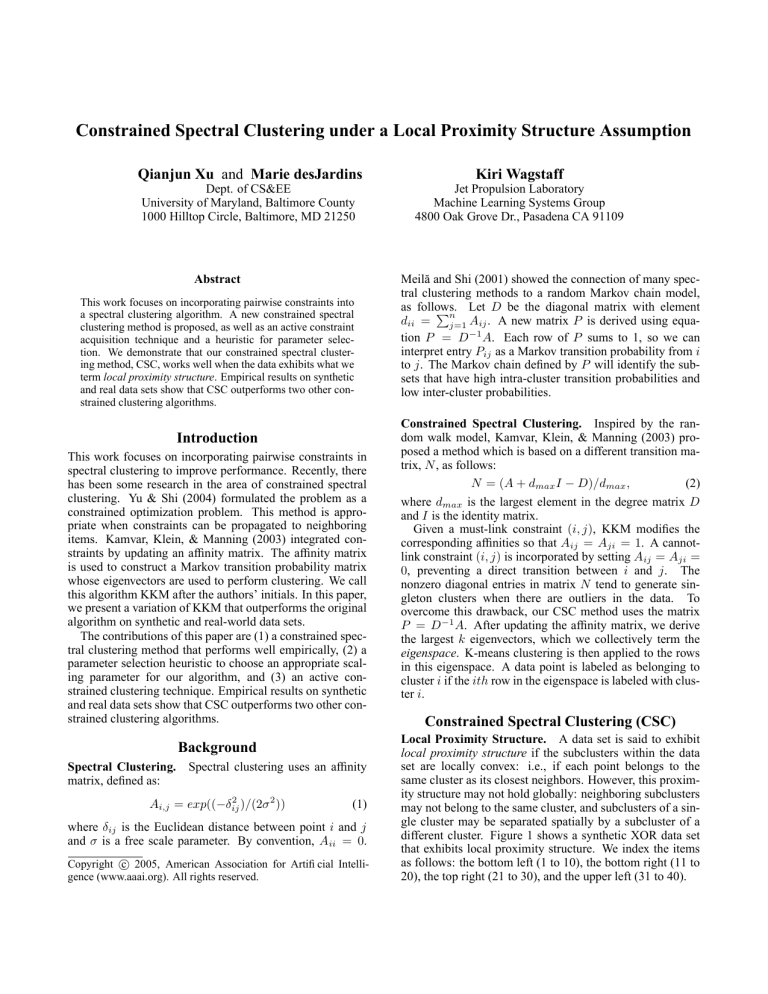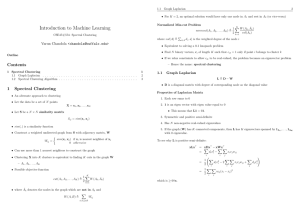
Constrained Spectral Clustering under a Local Proximity Structure Assumption
Qianjun Xu and Marie desJardins
Kiri Wagstaff
Dept. of CS&EE
University of Maryland, Baltimore County
1000 Hilltop Circle, Baltimore, MD 21250
Jet Propulsion Laboratory
Machine Learning Systems Group
4800 Oak Grove Dr., Pasadena CA 91109
Abstract
This work focuses on incorporating pairwise constraints into
a spectral clustering algorithm. A new constrained spectral
clustering method is proposed, as well as an active constraint
acquisition technique and a heuristic for parameter selection. We demonstrate that our constrained spectral clustering method, CSC, works well when the data exhibits what we
term local proximity structure. Empirical results on synthetic
and real data sets show that CSC outperforms two other constrained clustering algorithms.
Introduction
This work focuses on incorporating pairwise constraints in
spectral clustering to improve performance. Recently, there
has been some research in the area of constrained spectral
clustering. Yu & Shi (2004) formulated the problem as a
constrained optimization problem. This method is appropriate when constraints can be propagated to neighboring
items. Kamvar, Klein, & Manning (2003) integrated constraints by updating an affinity matrix. The affinity matrix
is used to construct a Markov transition probability matrix
whose eigenvectors are used to perform clustering. We call
this algorithm KKM after the authors’ initials. In this paper,
we present a variation of KKM that outperforms the original
algorithm on synthetic and real-world data sets.
The contributions of this paper are (1) a constrained spectral clustering method that performs well empirically, (2) a
parameter selection heuristic to choose an appropriate scaling parameter for our algorithm, and (3) an active constrained clustering technique. Empirical results on synthetic
and real data sets show that CSC outperforms two other constrained clustering algorithms.
Background
Spectral Clustering.
matrix, defined as:
Spectral clustering uses an affinity
2
)/(2σ 2 ))
Ai,j = exp((−δij
(1)
where δij is the Euclidean distance between point i and j
and σ is a free scale parameter. By convention, Aii = 0.
Copyright c 2005, American Association for Artificial Intelligence (www.aaai.org). All rights reserved.
Meilă and Shi (2001) showed the connection of many spectral clustering methods to a random Markov chain model,
as follows.
Pn Let D be the diagonal matrix with element
dii =
j=1 Aij . A new matrix P is derived using equation P = D −1 A. Each row of P sums to 1, so we can
interpret entry Pij as a Markov transition probability from i
to j. The Markov chain defined by P will identify the subsets that have high intra-cluster transition probabilities and
low inter-cluster probabilities.
Constrained Spectral Clustering. Inspired by the random walk model, Kamvar, Klein, & Manning (2003) proposed a method which is based on a different transition matrix, N , as follows:
N = (A + dmax I − D)/dmax ,
(2)
where dmax is the largest element in the degree matrix D
and I is the identity matrix.
Given a must-link constraint (i, j), KKM modifies the
corresponding affinities so that Aij = Aji = 1. A cannotlink constraint (i, j) is incorporated by setting Aij = Aji =
0, preventing a direct transition between i and j. The
nonzero diagonal entries in matrix N tend to generate singleton clusters when there are outliers in the data. To
overcome this drawback, our CSC method uses the matrix
P = D−1 A. After updating the affinity matrix, we derive
the largest k eigenvectors, which we collectively term the
eigenspace. K-means clustering is then applied to the rows
in this eigenspace. A data point is labeled as belonging to
cluster i if the ith row in the eigenspace is labeled with cluster i.
Constrained Spectral Clustering (CSC)
Local Proximity Structure. A data set is said to exhibit
local proximity structure if the subclusters within the data
set are locally convex: i.e., if each point belongs to the
same cluster as its closest neighbors. However, this proximity structure may not hold globally: neighboring subclusters
may not belong to the same cluster, and subclusters of a single cluster may be separated spatially by a subcluster of a
different cluster. Figure 1 shows a synthetic XOR data set
that exhibits local proximity structure. We index the items
as follows: the bottom left (1 to 10), the bottom right (11 to
20), the top right (21 to 30), and the upper left (31 to 40).
4
0.25
0.25
0.2
0.2
0.12
0.1
3.5
0.08
3
0.15
0.15
0.1
0.1
0.05
0.05
0
0
−0.05
−0.05
0.06
2.5
0.04
0.02
2
0
1.5
−0.02
1
−0.04
0.5
−0.06
0.5
1
1.5
2
2.5
3
3.5
Figure 1: The XOR data set.
4
−0.1
0
5
10
15
20
25
30
35
Figure 2: The 2nd eigenvector for the XOR data set with
no constraints.
Analyzing the Eigenvectors. Meilă & Shi (2001) defined
a piecewise constant eigenvector as one where the items
belonging to the same cluster have the same values in the
eigenvector. If we choose σ (in Equation 1) appropriately,
we can guarantee a piecewise constant eigenvector, as in
Figure 2 for the XOR data set.
Instead of directly estimating σ, we introduce a new parameter, m. Let δim represent the Euclidean distance of
point i to its mth closest neighbor. We choose σ so that
−max2
exp( 2σ2 δ ) = = 0.001, where maxδ = maxi {δim }.
This ensures that each point in the data set will have affinity
≥ to its m closest neighbors.
To choose m, we propose the following heuristic: (1)
compute the distance δij between all pairs of data points;
(2) sort each row δi. in ascending order; (3) find the distance
δim that has the largest gap with δi,m+1 ; and (4) select the
value for σ that maps this distance δim to affinity value (e.g., = 0.001). The intuition is that step (3) identifies
the largest natural “gap” in the data, and uses this to select
a good cluster size m, leading to an effective choice for σ.
Applying this heuristic on XOR yields m = 9, which is used
to compute the eigenvectors shown in Figures 2, 3, and 4.
Active Clustering. Since a piecewise constant eigenvector identifies subclusters, we can pick any point from each
subcluster as a representative. The constraints are obtained
by querying the user to label these representatives. For example, for the XOR data set, we construct queries about two
pairs of points: (1, 21) and (11, 31), which are both labeled
as must-link constraints. Figure 3 shows the 2nd eigenvector
after applying the first constraint. Figure 4 shows the eigenvector after applying both constraints. We can see that after
imposing only two actively selected must-link constraints,
the correct clusters for this hard problem are identified.
Experimental Results on Real-World Data
We have found experimentally that even with randomly selected constraints, CSC works well. We compare the performance of our CSC algorithm to that of KKM (Kamvar,
Klein, & Manning 2003) and CCL (Klein, Kamvar, & Manning 2002), using the soybean and iris data sets from the
UCI archive (Blake & Merz 1998). The Rand index (Rand
1971) (averaged over 100 runs) is plotted in Figures 5 and 6.
CSC outperforms CCL and KKM on these data sets.
40
−0.1
0
5
10
15
20
25
30
−0.08
40
0
35
Figure 3: The 2nd eigenvector for XOR with one constraint.
5
10
20
25
30
35
40
tor for XOR with two constraints.
1
0.94
0.98
0.92
0.96
0.9
0.94
0.88
0.92
0.9
0.88
CCL
KKM
CSC
0.86
0.84
0.82
0.86
0.8
CCL
KKM
CSC
0.84
0.82
15
Figure 4: The 2nd eigenvec-
rand index
0
rand index
0
0
10
20
30
40
50
0.78
60
0.76
0
10
# of constraints
20
30
40
50
60
# of constraints
Figure 5: The Rand index
Figure 6: The Rand index
for the soybean data set.
for the iris data set.
Compared to KKM, we believe that P is a better choice
than N for two main reasons. First, N can cause problems
when there are outliers in data set. Second, and more importantly, it cannot identify piecewise constant eigenvectors
for data sets that exhibit local proximity structure. The CCL
method performs worse than our algorithm on real data sets,
and cannot recognize subclusters easily when the data set
exhibits local proximity structure.
References
Blake, C., and Merz, C. 1998. UCI repository of machine
learning databases. http://www.ics.uci.edu/
∼mlearn/MLRepository.html.
Kamvar, S. D.; Klein, D.; and Manning, C. D. 2003. Spectral learning. In Proceedings of IJCAI-03, 561–566.
Klein, D.; Kamvar, S. D.; and Manning, C. D. 2002. From
instance-level constraints to space-level constraints: Making the most of prior knowledge in data clustering. In Proceedings of ICML-02, 307–314. Morgan Kaufmann.
Meilă, M., and Shi, J. 2001. A random walks view of
spectral segmentation. In Proceedings of AI-STAT’01.
Rand, W. 1971. Objective criteria for the evaluation of
clustering methods. Journal of the American Statistical Association 66:846–850.
Yu, S. X., and Shi, J. 2004. Segmentation given partial
grouping constraints. IEEE Transactions on Pattern Analysis and Machine Intelligence 26(2):173–183.






